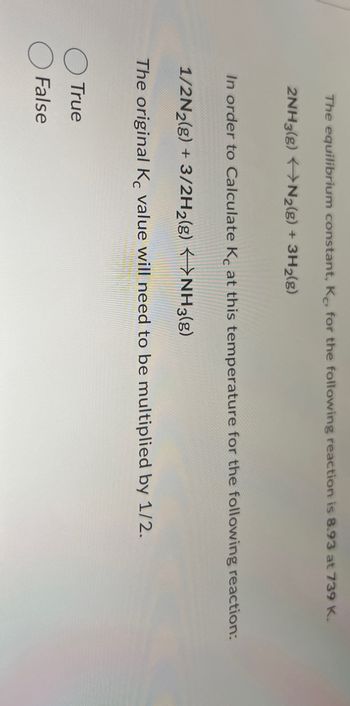
Chemistry
10th Edition
ISBN: 9781305957404
Author: Steven S. Zumdahl, Susan A. Zumdahl, Donald J. DeCoste
Publisher: Cengage Learning
expand_more
expand_more
format_list_bulleted
Question

Transcribed Image Text:The equilibrium constant, K, for the following reaction is 8.93 at 739 K.
2NH3(g) N2(g) + 3H2(g)
In order to Calculate Kc at this temperature for the following reaction:
1/2N2(g) + 3/2H2(g) NH3(g)
The original Kc value will need to be multiplied by 1/2.
True
False
Expert Solution
This question has been solved!
Explore an expertly crafted, step-by-step solution for a thorough understanding of key concepts.
Step by stepSolved in 2 steps with 2 images

Knowledge Booster
Similar questions
- Calculate Kc for the following equilibrium: 2SO2(g) + O2(g) ⇌ 2SO3(g); Kp = 2.5 × 1010 at 625 K. Kc = × 10arrow_forwardConsider the reaction: 2 NH3(g) = N₂(g) + 3 H₂(g). At T = 740 K, the equilibrium constant K for this reaction is K₂ = 10. 22. What is the correct form of the equilibrium constant K for this reaction? (A) Kc = (B) Kc = (C) Kc = 2[NH3] [N₂] + 3[H₂] (D) Kc = (E) Kc = [N₂][H₂]³ [N₂] + 3[H₂] 2[NH3] [NH3]² [N₂] [H₂] 3³ 3 [N₂] [H₂]³ 2 [NH3]²arrow_forwardConsider the synthesis of ammonia: N2(g) + 3H2(g)<=>2NH3(g) At 926.5 °C, the equilibrium constant Kp is 4.09 × 10–5. What is the value of Kc?arrow_forward
- At 1100 K, Kp = 0.21 for the reaction 2SO2 (g) + O2 (g) = 2SO3 (g) What is the value of K at this temperature? K =arrow_forwardCl3] ² [Hz] ² [A] [AC] Consider the chemical equation and equilibrium constant for the synthesis of ammonia at 25 °C: N₂ (g) + 3 H₂ (g) = 2 NH3 (g) K = 5.6 x 105 Calculate the equilibrium constant for the following reaction at 25 °C: NH3 (g) 1/2 N₂ (g) + 3/2 H₂ (g) K' = ? Kc = [NH3 ]² [₂] [H₂]] Kc- [~₂] ¹/2 [H NH3arrow_forwardConsider the following equilibrium: CO(g) + 3 H2(g)⇄CH4(g) + H2O(g). If Kp = 5.25 x 10-5 at 1468.0 K, calculate Kc.arrow_forward
- Calculate the value of K, for the equation C(s) + CO₂(g) given that at a certain temperature Kp = 2 CO(g) K₂ = ? C(s) + 2 H₂O(g) CO₂(g) + 2 H₂(g) H₂(g) + CO₂(g) = H₂O(g) + CO(g) Kpl = 3.35 Kp2 = 0.745arrow_forwardUsing any data you can find in the ALEKS Data resource, calculate the equilibrium constant K at 25.0 °C for the following reaction. 2 NH3 (9) N₂H₁(g) + H₂ (9) Round your answer to 2 significant digits. K = 0 x10 x ⑤arrow_forwardFor this equilibrium system, 2SO3(g) 2 25O2(g) + O2(g), Kc = 0.00407. At equilibrium, you would expect to find %3D relatively more products than reactant. relatively more reactant than products. about comparable amounts of reactant and products. no way to decide.arrow_forward
- Do not give handwriting solution. Given the following equilibrium reaction and equilibrium constant at 300 K: 2 SO3 (g) ⇌ O2 (g) + 2 SO2 (g) Kp = 0.049 calculate the equilibrium constant (Kp) for the following reaction at the same temperature. Enter your answer with no units. 3 O2 (g) + 6 SO2 (g) ⇌ 6 SO3 (g) Kp = ?arrow_forwardNitrogen dioxide decomposes according to the reaction 2 NO2 (g) ⇌ 2 NO (g) + O2 (g) Where Kp = 4.48 x 10 ^ -13 at a certain temperature. If 0.40 atm of NO is added to a container and allowed to come to equilibrium, what are the equilibrium partial pressures of NO (g) and O2 (g)? P NO = atm NO P O2 = atm O2 Use correct significant figures.arrow_forwardFor which of these reactions will there be no effect on the relative amounts of the substances present at equilibrium when the pressure of the system is increased at constant temperature? O 2 sO, (g) + 0,(g) = 2 SO, (g) + heat heat + CO, (g) + NO(g) =CO(g) + NO, (g) heat + 2 Cl, (g) + 2 H,O(g) = 4 HCI(g) + 0, (g) N, (g) + 3 H, (g) = 2 NH, (g) + heatarrow_forward
arrow_back_ios
SEE MORE QUESTIONS
arrow_forward_ios
Recommended textbooks for you
 ChemistryChemistryISBN:9781305957404Author:Steven S. Zumdahl, Susan A. Zumdahl, Donald J. DeCostePublisher:Cengage Learning
ChemistryChemistryISBN:9781305957404Author:Steven S. Zumdahl, Susan A. Zumdahl, Donald J. DeCostePublisher:Cengage Learning ChemistryChemistryISBN:9781259911156Author:Raymond Chang Dr., Jason Overby ProfessorPublisher:McGraw-Hill Education
ChemistryChemistryISBN:9781259911156Author:Raymond Chang Dr., Jason Overby ProfessorPublisher:McGraw-Hill Education Principles of Instrumental AnalysisChemistryISBN:9781305577213Author:Douglas A. Skoog, F. James Holler, Stanley R. CrouchPublisher:Cengage Learning
Principles of Instrumental AnalysisChemistryISBN:9781305577213Author:Douglas A. Skoog, F. James Holler, Stanley R. CrouchPublisher:Cengage Learning Organic ChemistryChemistryISBN:9780078021558Author:Janice Gorzynski Smith Dr.Publisher:McGraw-Hill Education
Organic ChemistryChemistryISBN:9780078021558Author:Janice Gorzynski Smith Dr.Publisher:McGraw-Hill Education Chemistry: Principles and ReactionsChemistryISBN:9781305079373Author:William L. Masterton, Cecile N. HurleyPublisher:Cengage Learning
Chemistry: Principles and ReactionsChemistryISBN:9781305079373Author:William L. Masterton, Cecile N. HurleyPublisher:Cengage Learning Elementary Principles of Chemical Processes, Bind...ChemistryISBN:9781118431221Author:Richard M. Felder, Ronald W. Rousseau, Lisa G. BullardPublisher:WILEY
Elementary Principles of Chemical Processes, Bind...ChemistryISBN:9781118431221Author:Richard M. Felder, Ronald W. Rousseau, Lisa G. BullardPublisher:WILEY

Chemistry
Chemistry
ISBN:9781305957404
Author:Steven S. Zumdahl, Susan A. Zumdahl, Donald J. DeCoste
Publisher:Cengage Learning

Chemistry
Chemistry
ISBN:9781259911156
Author:Raymond Chang Dr., Jason Overby Professor
Publisher:McGraw-Hill Education

Principles of Instrumental Analysis
Chemistry
ISBN:9781305577213
Author:Douglas A. Skoog, F. James Holler, Stanley R. Crouch
Publisher:Cengage Learning

Organic Chemistry
Chemistry
ISBN:9780078021558
Author:Janice Gorzynski Smith Dr.
Publisher:McGraw-Hill Education

Chemistry: Principles and Reactions
Chemistry
ISBN:9781305079373
Author:William L. Masterton, Cecile N. Hurley
Publisher:Cengage Learning

Elementary Principles of Chemical Processes, Bind...
Chemistry
ISBN:9781118431221
Author:Richard M. Felder, Ronald W. Rousseau, Lisa G. Bullard
Publisher:WILEY